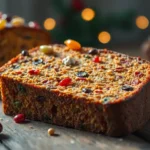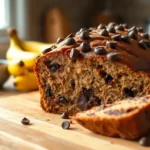We’ve discovered the perfect way to elevate your classic chocolate chip cookie game with a nutty twist that’ll have everyone asking for the recipe. Rye chocolate chip cookies bring together the earthy depth of rye flour with rich chocolate chips to create something truly special that stands out from ordinary cookies.
This isn’t your grandmother’s chocolate chip cookie – it’s so much better. The rye flour adds a subtle complexity and hearty texture that perfectly complements the sweetness of chocolate chips. We love how these cookies strike the perfect balance between familiar comfort and exciting new flavors.
What makes these cookies absolutely irresistible is their unique chewy texture and sophisticated taste profile. The rye flour creates a slightly denser bite while maintaining that soft center we all crave. Whether you’re looking to impress guests or simply want to treat yourself to something extraordinary, these rye chocolate chip cookies deliver bakery-quality results right from your home kitchen.
Ingredients
We’ve carefully selected each ingredient to create the perfect balance of earthy rye flavor and sweet chocolate indulgence. Our ingredient list combines traditional baking staples with the distinctive character of rye flour.
Dry Ingredients
- 1½ cups rye flour
- ½ cup all-purpose flour
- 1 teaspoon baking soda
- 1 teaspoon fine sea salt
- ½ teaspoon ground cinnamon
Wet Ingredients
- ¾ cup unsalted butter, softened to room temperature
- ¾ cup packed light brown sugar
- ½ cup granulated sugar
- 2 large eggs, room temperature
- 2 teaspoons pure vanilla extract
Mix-Ins
- 1½ cups semi-sweet chocolate chips
- ½ cup chopped walnuts (optional)
- 2 tablespoons turbinado sugar for sprinkling
Equipment Needed
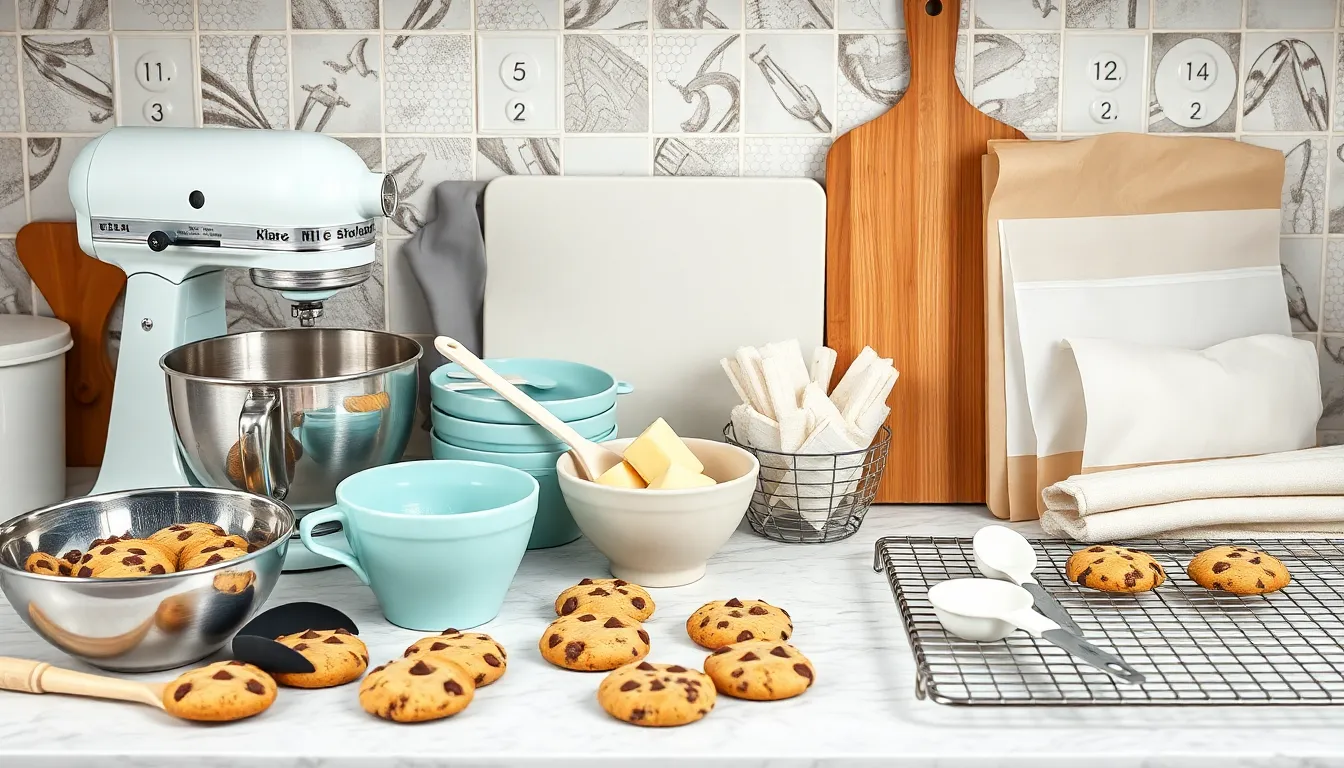
Creating these delicious rye chocolate chip cookies requires several essential tools that ensure perfect results every time. We recommend gathering all equipment before starting to streamline your baking process.
Mixing bowls serve as the foundation for combining both dry and wet ingredients separately. Large bowls prevent spillage when mixing and provide ample space for thorough ingredient incorporation.
An electric mixer makes creaming butter and sugar effortless, though hand mixing works perfectly fine for those who prefer a more traditional approach. Stand mixers or handheld electric mixers both deliver excellent results.
Measuring cups and spoons guarantee accuracy in our ingredient ratios. Precise measurements become crucial when working with rye flour, as its unique properties require exact proportions for optimal texture.
A sturdy spatula helps fold chocolate chips into the dough without overmixing. Rubber or silicone spatulas work best for scraping bowl sides and ensuring even distribution of ingredients.
Baking sheets provide the cooking surface for our cookies. Heavy-duty aluminum sheets distribute heat evenly and prevent hot spots that could cause uneven browning.
Parchment paper or silicone baking mats create a non-stick surface that makes cookie removal simple and cleanup quick. These tools also prevent cookies from sticking and breaking during transfer.
A cooling rack allows proper air circulation around freshly baked cookies. This equipment prevents soggy bottoms and maintains the perfect crispy exterior texture we want.
Cookie scoops or tablespoons ensure uniform cookie sizes that bake evenly. Consistent portioning creates professional-looking results and prevents some cookies from burning while others remain underdone.
Having these tools ready transforms cookie baking from chaotic to organized, setting you up for rye chocolate chip cookie success.
Instructions
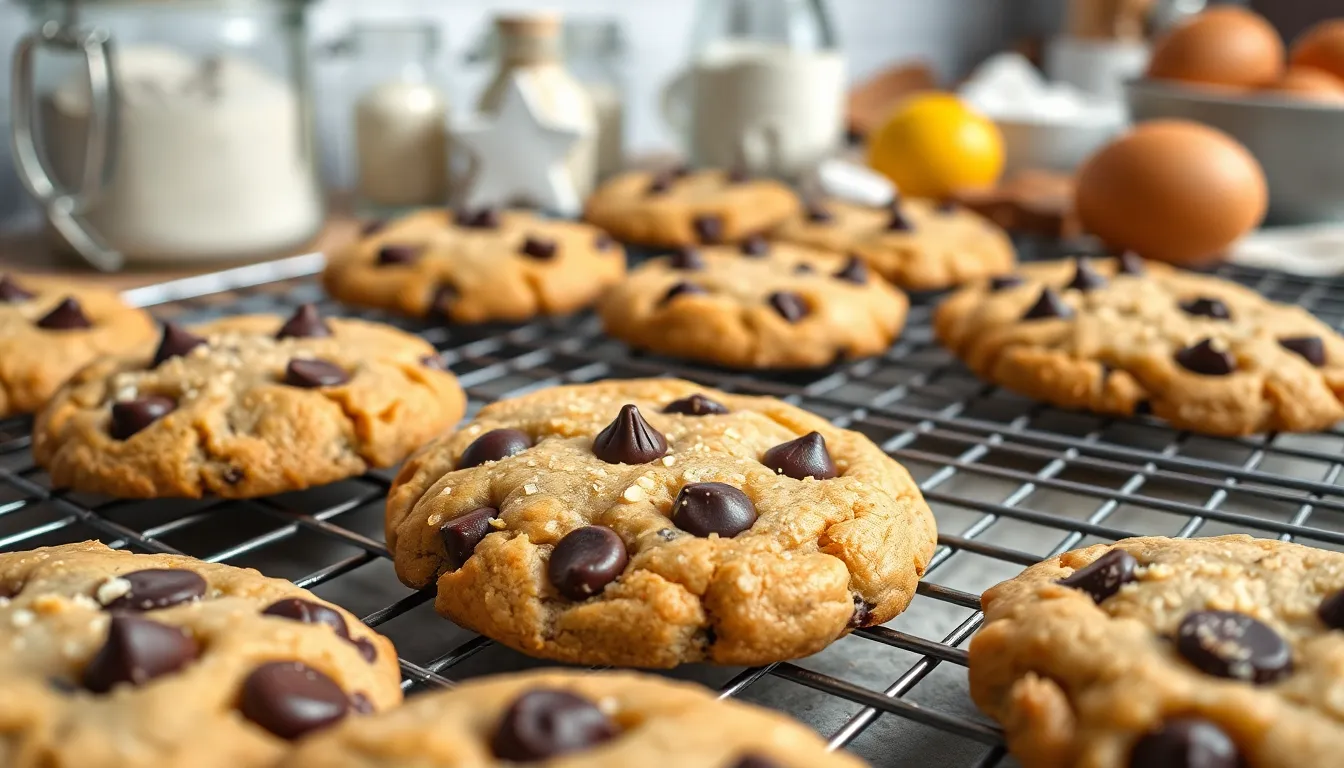
Follow these detailed steps to create perfectly textured rye chocolate chip cookies with crispy edges and chewy centers. We’ll guide you through each stage to ensure bakery-quality results every time.
Prep the Dough
We start by combining our dry ingredients in a medium bowl. Whisk together the rye flour, all-purpose flour, baking soda, fine sea salt, and ground cinnamon until evenly distributed.
Using an electric mixer, cream the softened butter with both brown sugar and granulated sugar in a large bowl for 3-4 minutes until light and fluffy. Beat in the eggs one at a time, ensuring each is fully incorporated before adding the next. Add the vanilla extract and mix until combined.
Gradually add the dry ingredient mixture to the wet ingredients, mixing on low speed until just combined. Avoid overmixing to prevent tough cookies. Fold in the chocolate chips and optional walnuts using a sturdy spatula, distributing them evenly throughout the dough.
Chill the Dough
We recommend chilling the dough for optimal texture and flavor development. Cover the bowl tightly with plastic wrap and refrigerate for at least 30 minutes.
For future baking convenience, scoop the dough into portions using a cookie scoop and place on a parchment-lined baking sheet. Freeze these dough balls for 2 hours, then transfer to freezer bags for storage up to 3 months. Frozen dough can be baked directly from the freezer with an additional 1-2 minutes of baking time.
Bake the Cookies
Preheat your oven to 375°F and line heavy-duty baking sheets with parchment paper. Using a cookie scoop or tablespoon, portion the chilled dough into uniform balls and place them 2 inches apart on the prepared baking sheets.
Lightly sprinkle each dough ball with turbinado sugar for extra crunch and visual appeal. Bake for 10-13 minutes until the edges turn golden brown while the centers still appear slightly underbaked.
Rotate the baking sheets halfway through cooking for even browning. The cookies will continue cooking on the hot pan after removal from the oven.
Cool and Store
Allow the cookies to cool on the baking sheets for 5 minutes before transferring to a wire cooling rack. This resting period prevents breaking while ensuring the cookies maintain their chewy texture.
Store completely cooled cookies in an airtight container at room temperature for up to 3-4 days. Layer cookies between parchment paper to prevent sticking and maintain their texture.
| Storage Method | Duration | Temperature |
|---|---|---|
| Airtight container | 3-4 days | Room temperature |
| Freezer storage | 3 months | 0°F |
| Dough balls frozen | 3 months | 0°F |
Tips for Perfect Rye Chocolate Chip Cookies

Mastering rye chocolate chip cookies requires attention to exact details that differ from traditional cookie recipes. We’ve gathered essential insights to help you create the perfect batch every time.
Choosing the Right Rye Flour
Selecting finely ground rye flour makes all the difference in achieving optimal texture and preventing excessive spreading during the baking process. We recommend using dark rye flour specifically for its ability to create chewy cookies with a distinctly toasted nutty flavor profile. This type of flour integrates seamlessly with other ingredients while maintaining the cookie’s structural integrity throughout the baking process.
Chocolate Chip Selection
Dark chocolate with high cocoa content between 50-70% creates the ideal flavor balance for rye chocolate chip cookies. We find this percentage range complements the nutty earthiness of rye flour without overwhelming its subtle complexity. The rich cocoa notes enhance rather than compete with the grain’s natural flavor characteristics.
Dough Consistency Tips
Accurate ingredient measurement using a baking scale prevents the common issue of overmeasuring flour that leads to tough cookies. We strongly advocate for weighing ingredients rather than using volume measurements for consistent results. Some recipes allow you to skip the chilling step for quicker preparation while others benefit from refrigeration for improved dough handling. Baking time flexibility lets you achieve your preferred texture by baking for 12-13 minutes for chewy centers or extending the time for crispier results. Consider incorporating unique flavor additions like rosemary or bourbon to elevate the complexity of your final product.
Variations and Substitutions

Rye chocolate chip cookies offer endless opportunities for customization while maintaining their distinctive earthy character. We can adjust flour ratios chocolate types and add-ins to create our perfect version of this sophisticated treat.
Different Flour Blends
We recommend starting with a balanced approach using 1 cup all-purpose flour to ½ cup rye flour for those new to rye baking. This ratio provides subtle rye influence without overwhelming the familiar cookie taste. For bakers seeking a more pronounced nutty flavor we suggest increasing the rye proportion to an equal blend of 1½ cups each of all-purpose and rye flour.
| Flour Ratio | Rye Flavor Profile | Best For |
|---|---|---|
| 2:1 All-purpose to Rye | Subtle rye influence | First-time rye bakers |
| 1:1 All-purpose to Rye | Nutty complex profile | Experienced bakers |
The type of rye flour we choose significantly impacts the final flavor. Lighter rye flour like medium white rye yields a milder taste that pairs beautifully with chocolate. Darker rye flour introduces deeper earthier notes that create a more robust cookie experience.
Chocolate Alternatives
High-quality dark chocolate with 70% cacao or higher works best in rye chocolate chip cookies. The intense cocoa flavor complements rye’s nuttiness while balancing the overall sweetness perfectly. We prefer chopped dark chocolate bars or baking wafers over standard chips because they create better melting and ribboning throughout each cookie.
Semisweet chocolate serves as an acceptable alternative though it may increase sweetness levels. We rarely recommend milk chocolate since its excess sweetness can overpower the sophisticated rye flavor profile. Combining different brands or types of dark chocolate enhances the molten effect and adds complexity to each bite.
Add-In Options
Fresh herbs like rosemary add an aromatic dimension to rye chocolate chip cookies. We sometimes omit herbs to let the rye flavor dominate but rosemary creates an elegant complement when used sparingly. Warm spices such as cinnamon or cardamom pair exceptionally well with rye’s natural depth.
A small amount of bourbon approximately 1 tablespoon integrates seamlessly into the dough for subtle complexity. This addition enhances the earthy undertones without creating an overwhelming alcohol flavor. We finish our baked cookies with flaky salt to create a savory contrast that highlights both the chocolate and rye elements beautifully.
Storage Instructions

Proper storage maintains the texture and flavor of our rye chocolate chip cookies for extended enjoyment. We recommend several methods depending on how long you plan to keep your cookies fresh.
Room Temperature Storage
Storing cookies at room temperature works best for immediate consumption. We place our rye chocolate chip cookies in an airtight container where they stay fresh for 3-4 days. Some recipes allow for storage up to one week when properly sealed.
To maintain soft texture, we add a slice of white bread or apple piece to the container. This method helps preserve moisture and prevents the cookies from becoming overly crispy.
Refrigeration Method
Refrigerator storage extends freshness while maintaining ideal texture. Our cookies remain at peak quality for 3-4 days when stored in the refrigerator. This method particularly benefits cookies in humid climates where room temperature storage might cause texture changes.
We wrap cookies in plastic wrap or place them in sealed containers before refrigerating to prevent absorption of other flavors.
Freezing for Long-Term Storage
Freezing provides the longest storage option for our rye chocolate chip cookies. Properly frozen cookies maintain quality for 2-6 months depending on the storage method used.
| Storage Method | Duration | Best Practice |
|---|---|---|
| Room Temperature | 3-4 days | Airtight container with bread slice |
| Refrigeration | 3-4 days | Sealed container or plastic wrap |
| Freezing | 2-6 months | Freezer-safe wrap or bags |
We wrap individual cookies in freezer-safe plastic wrap or place them in freezer bags with excess air removed. For serving, we microwave frozen cookies for 15-20 seconds to restore their fresh-baked warmth and texture.
Make-Ahead Storage Tips
Rolling cookie dough into balls and freezing them allows for fresh cookies anytime. We place dough balls on baking sheets until frozen solid, then transfer to freezer bags for storage.
When ready to bake, we let frozen dough balls sit at room temperature for a few minutes before placing them in the preheated oven. This method ensures consistent baking results while maintaining the cookies’ signature chewy texture and earthy rye flavor.
Make-Ahead Tips
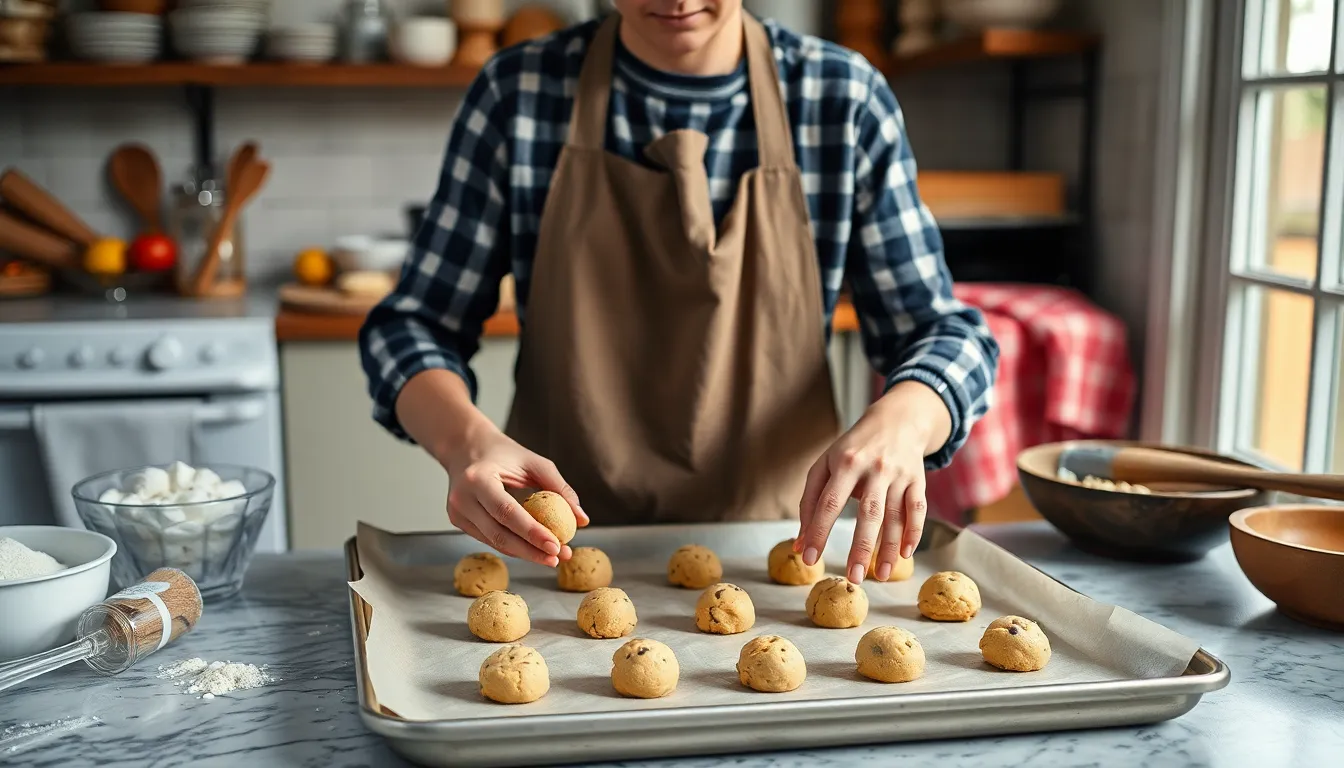
We understand that planning ahead makes baking these delightful rye chocolate chip cookies even more convenient. Rolling cookie dough into balls and freezing them allows us to bake fresh cookies whenever we need them. Simply form the dough into portions and place them on a parchment-lined baking sheet before transferring to the freezer.
Our freezer storage method ensures we always have cookie dough ready for unexpected guests or sudden cravings. Store the frozen dough balls in freezer-safe bags or containers for up to three months. When we’re ready to bake, we leave the dough at room temperature for just a few minutes before placing them in the oven.
Chilling the dough presents another excellent make-ahead strategy that actually improves our cookies’ final texture and flavor. We refrigerate the cookie dough for at least two hours, though overnight chilling delivers the best results. The extended chilling time allows the rye flour to fully hydrate while the flavors meld together beautifully.
Organizing our chilled dough properly streamlines the baking process when we’re ready to proceed. We scoop the dough into portions and store them in a covered container or arrange them on a parchment-lined sheet pan in the refrigerator. The dough balls can sit close together during storage since we’ll separate them before baking.
Maintaining cold dough temperature until the moment we’re ready to bake ensures optimal spread and texture in our finished cookies. We keep the dough refrigerated until just before portioning onto our baking sheets. This temperature control helps us achieve those perfect crispy edges and chewy centers that make these rye chocolate chip cookies so irresistible.
Batch preparation becomes effortless when we use these make-ahead techniques effectively. We can prepare multiple batches of dough on weekends and store them using either the refrigeration or freezing method. This approach allows us to enjoy fresh-baked cookies throughout the week without repeating the entire mixing process.
Troubleshooting Common Issues

Even experienced bakers can encounter challenges when working with rye flour in chocolate chip cookies. We’ve compiled the most common issues and their proven answers to help you achieve perfect results every time.
Cookies Spreading Too Much
When our cookies spread excessively during baking, the culprit is often the texture of our rye flour. We recommend using finely ground rye flour rather than coarsely ground varieties, as the coarser texture absorbs moisture differently and causes unwanted spreading. Room temperature butter is essential—butter that’s too warm will create excess spreading before the cookies have time to set properly. Also, we should avoid over-mixing our dough once we add the flour mixture, as this can break down the structure and lead to flat cookies.
Cookies Falling Flat
Flat cookies typically result from temperature and mixing issues we can easily control. We need to ensure our butter reaches the perfect room temperature consistency—soft enough to cream but not melted or overly warm. Over-mixing our dough breaks down the carefully created structure, so we mix just until ingredients combine. Sugar plays a crucial role in cookie structure, and using too little can cause our cookies to fall flat during baking. Adding slightly more sugar can provide the lift and structure our cookies need.
Uneven Baking Results
Achieving uniformly baked cookies requires attention to sizing and measurement accuracy. We ensure each cookie portion is the same size using a cookie scoop or measuring spoon for consistent results. A baking scale helps us measure ingredients precisely—over-measuring flour is a common mistake that affects texture and baking consistency. Uniform sizing allows all cookies to bake at the same rate, preventing some from being overdone while others remain underbaked.
Cookies Not Achieving Desired Chewiness
The key to perfectly chewy rye chocolate chip cookies lies in our baking time and cooling method. We bake our cookies just until the edges turn lightly golden while the centers still appear slightly underbaked. Overbaking creates hard, crunchy cookies instead of the chewy texture we desire. After removing them from the oven, we let our cookies cool on the baking sheet for several minutes before transferring to a cooling rack.
Selecting the Right Rye Flour
Our choice of rye flour significantly impacts the final texture and flavor of our cookies. We prefer dark rye flour for its chewy texture and distinctive toasted nutty flavor that complements chocolate beautifully. Coarsely ground rye flour creates moisture absorption issues, so we stick with finely ground varieties for optimal results.
| Baking Factor | Optimal Range | Result
|—————|—————|
| Baking Time | 11.5-13 minutes | Chewy texture with golden edges
| Butter Temperature | Room temperature (65-68°F) | Proper creaming and structure
| Flour Type | Finely ground dark rye | Even moisture absorption and nutty flavor
We achieve the best results by maintaining room temperature butter throughout our process and avoiding the temptation to over-mix our dough. These simple adjustments transform common baking challenges into consistently successful batches of delicious rye chocolate chip cookies.
Conclusion
We’ve discovered that rye chocolate chip cookies offer an exceptional upgrade to the beloved classic. The earthy depth and distinctive texture make every bite memorable while the flexibility in customization ensures you’ll find your perfect version.
These cookies prove that baking innovation doesn’t require complex techniques. With proper preparation and the right storage methods you can enjoy fresh cookies whenever the craving strikes.
Whether you’re seeking to impress guests or simply want to elevate your everyday treats rye chocolate chip cookies deliver sophistication without sacrificing comfort. The nutty complexity paired with rich chocolate creates a harmonious balance that sets these cookies apart from ordinary recipes.
Frequently Asked Questions
What makes rye chocolate chip cookies different from regular chocolate chip cookies?
Rye chocolate chip cookies have a distinctive earthy, nutty flavor and denser, chewier texture compared to traditional cookies. The rye flour adds complexity and depth while balancing the sweetness of chocolate chips. This creates a more sophisticated taste profile that’s both hearty and satisfying.
What type of rye flour should I use for these cookies?
Use finely ground dark rye flour for the best texture and flavor. Dark rye flour provides deeper, more complex notes compared to lighter varieties. Avoid coarsely ground rye flour as it can create a gritty texture in your cookies.
Can I substitute all-purpose flour with rye flour completely?
For beginners, start with a 2:1 ratio of all-purpose to rye flour. Experienced bakers can use a 1:1 ratio for a more pronounced rye flavor. Using 100% rye flour will create very dense cookies with an intense earthy taste that may be overwhelming.
How long should I chill the cookie dough?
Chill the dough for at least 2 hours, though overnight chilling produces the best results. This allows the rye flour to fully hydrate, develops better flavor, and prevents excessive spreading during baking. You can also freeze dough balls for up to 3 months.
What’s the best chocolate to use with rye flour?
Dark chocolate with 50-70% cocoa content works best as it complements the nutty earthiness of rye flour. High-quality dark chocolate with 70% cacao or higher is ideal. Avoid overly sweet chocolate that might compete with the complex rye flavors.
How do I prevent my rye cookies from spreading too much?
Ensure your butter is properly softened (not melted), chill the dough adequately, and avoid over-mixing. Use the correct flour ratios and make sure your baking sheets aren’t too warm. Properly chilled dough holds its shape better during baking.
How should I store rye chocolate chip cookies?
Store cookies in an airtight container at room temperature for 3-4 days. Add a slice of bread or apple to maintain moisture. For longer storage, refrigerate for 3-4 days or freeze for 2-6 months. Frozen cookies should be thawed at room temperature.
Can I add other ingredients to enhance the flavor?
Yes! Try adding fresh rosemary, warm spices like cinnamon, or a splash of bourbon for complexity. Chopped walnuts provide extra texture, while a sprinkle of flaky sea salt on top creates a delicious sweet-savory contrast that highlights both chocolate and rye flavors.
Why are my rye cookies turning out flat?
Flat cookies usually result from under-chilled dough, too much butter, or over-mixing. Ensure your dough is properly chilled, measure ingredients accurately (preferably by weight), and mix just until combined. Also check that your baking soda is fresh and active.
Can I make the cookie dough ahead of time?
Absolutely! Roll dough into balls and freeze them for up to 3 months in freezer-safe containers. You can bake directly from frozen (add 1-2 extra minutes) or thaw briefly before baking. This makes it easy to have fresh cookies anytime.



